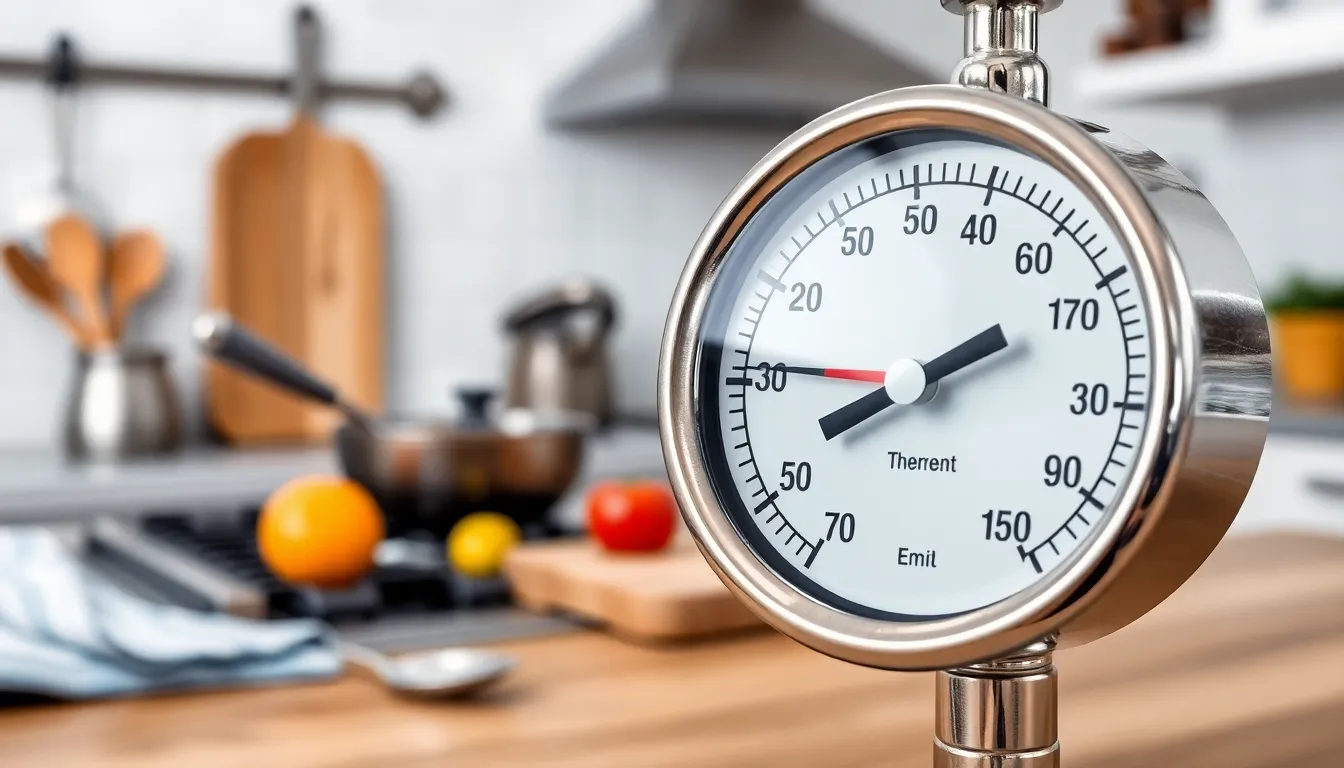When it comes to baking or cooking, a precise temperature can mean the difference between a culinary masterpiece and a total disaster. Ever wonder what 180°C is in Fahrenheit? If you’ve ever found yourself squinting at a recipe that uses metric temperatures, you’re not alone. Converting Celsius to Fahrenheit can feel like trying to solve a Rubik’s Cube blindfolded.
Table of Contents
ToggleUnderstanding Temperature Conversion
Understanding temperature conversion is essential for successful cooking and baking. The Celsius and Fahrenheit scales represent temperature in different ways. A common conversion formula exists for this process: multiply the Celsius temperature by 1.8, then add 32 to find the Fahrenheit equivalent.
For example, converting 180°C to Fahrenheit involves this simple calculation:
- Multiply 180 by 1.8 to get 324.
- Add 32 to 324, resulting in 356°F.
He or she can confidently claim that 180°C equals 356°F. Knowing this conversion helps cooks adapt recipes that utilize different measurement systems.
Many resources simplify this process, including conversion charts and apps. Familiarizing oneself with these tools ensures accuracy in the kitchen. Learning common temperature conversions enhances culinary skills, making it easier to follow diverse recipes.
Converting temperatures can feel daunting, yet practice builds confidence. Relying on precise measurements fosters successful outcomes in dishes, whether baking bread or roasting meat. Chefs and home cooks alike benefit from mastering conversions, eliminating reliance on guesswork.
Ultimately, accurate temperature management contributes to consistency and success in cooking and baking. By understanding the relationship between Celsius and Fahrenheit, anyone can make informed choices while preparing meals. The correct temperature can transform a recipe, allowing culinary creations to shine.
Celsius and Fahrenheit: An Overview

Understanding Celsius and Fahrenheit enhances precise temperature measurement in culinary practices. Each scale represents temperature uniquely, which is essential for accurate cooking results.
The Celsius Scale
The Celsius scale, widely used around the world, defines the freezing point of water at 0°C and its boiling point at 100°C. This metric system is straightforward, as temperatures increase or decrease smoothly within these bounds. It facilitates easier calculations during recipe adjustments. Many recipes use Celsius measurements, especially in regions utilizing the metric system, making familiarity with this scale vital for cooks.
The Fahrenheit Scale
In contrast, the Fahrenheit scale primarily serves as the standard in the United States. Water freezes at 32°F and boils at 212°F, establishing a less intuitive scale for those accustomed to Celsius. This scale reflects smaller temperature increments, leading to more granular temperature adjustments. Understanding Fahrenheit is crucial for American cooks to navigate recipes and achieve perfect outcomes. The difference in scale emphasizes the importance of accurate conversions when switching between systems.
Converting 180°C to Fahrenheit
Converting 180°C into Fahrenheit requires a simple mathematical formula. The formula involves multiplying the Celsius temperature by 1.8, then adding 32 to the result.
The Conversion Formula
To convert Celsius to Fahrenheit, use the formula:
F = (C × 1.8) + 32.
When applying this to 180°C:
F = (180 × 1.8) + 32, leading to a final value of 356°F. Recognizing this conversion helps ensure accuracy in cooking, especially when dealing with recipes from different regions.
Step-by-Step Conversion
Start by multiplying 180 by 1.8, which equals 324. Next, add 32 to 324 to reach the final conversion of 356°F. This straightforward process guides cooks through Celsius to Fahrenheit conversions confidently. By practicing this method, cooks can efficiently adapt recipes and maintain the desired results.
Practical Applications of Temperature Conversion
Temperature conversion plays a vital role in culinary practices. Many recipes use varying temperature scales, requiring cooks to adapt accordingly. Familiarity with the conversion between Celsius and Fahrenheit enhances cooking precision. For example, when a recipe calls for 180°C, converting it to Fahrenheit allows for accurate baking results.
The application of conversion charts or mobile apps streamlines this process. Resources like these provide quick reference points, ensuring efficient measurements. Additionally, knowing key temperature equivalents fosters confidence in the kitchen. For instance, understanding that 356°F aligns with a popular baking temperature can guide baking decisions effectively.
Various cooking techniques also demand specific temperature settings. Roasting meats often requires higher temperatures, while simmering typically needs lower settings. Cooks can leverage temperature knowledge to adjust cooking times and methods seamlessly. For example, if one shifts from Celsius to Fahrenheit, knowing typical cooking ranges supports better timing in dishes.
Mastering temperature conversions contributes to improved culinary versatility. It allows cooks to experiment with international recipes, ensuring authentic flavors are maintained. Cooking practices around the world sometimes use different scales, making accurate conversions essential for successful outcomes. When cooks apply these conversions, they achieve consistency in their culinary creations.
The integration of precise temperature knowledge elevates meal preparation beyond basic cooking. A cuisine’s authenticity hinges on factors like proper temperature management. Achieving the right results fosters a deeper appreciation for the cooking craft itself. By understanding and applying temperature conversions, culinary enthusiasts can enhance their skills and enjoy the art of cooking more fully.
Understanding the conversion from Celsius to Fahrenheit is vital for anyone looking to perfect their culinary skills. With 180°C translating to 356°F, cooks can confidently tackle recipes from various regions without fear of inaccuracies. Utilizing conversion charts and apps can simplify this process, making it easier to achieve consistent results in the kitchen. Mastering these conversions not only enhances cooking but also allows for a deeper appreciation of international cuisines. By embracing the nuances of temperature management, culinary enthusiasts can ensure their dishes shine, reflecting their dedication and skill.